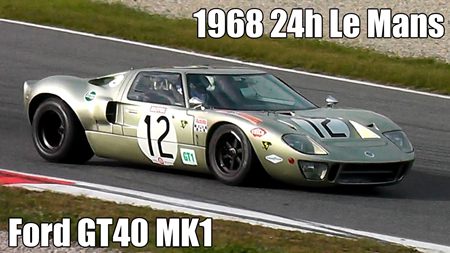The road-going and now legendary GT 40 was once hard for Ford to sell through its dealerships.
To be able to race the GT 40 at Le Mans required FIA homologation which meant that a certain number of the cars had to be sold as road cars. To move the 20 or so cars built for homologation purposes, Ford promoted the car with a dealer roadshow and discounting, eventually clearing its inventory with very little (or perhaps no) profit.
The Ford GT 40, designed to beat Ferrari, captured overall victory at Le Mans from 1966 through 1969, and won scores of other races in Europe and the United States.
Race cars do not become instant success as road cars. Entry and exit was challenging for those dressed in street clothes, and the World Registry of Cobras & GT 40s, 4th Edition, describes entry and exit from the GT 40 as a “spectator event.”
 Ford GT 40.
Ford GT 40.
The challenges of owning a GT40 as a daily driver didn’t end there, either. The doors needed a wide opening to negotiate across the wide sill, requiring owners to park on the outskirts of parking lots and hope for the best. Rear-side visibility was limited by enormous C-pillars, ventilation was provided only by small rectangular windows cut within the door glass (which also made paying tolls a challenge), being built in the UK, the car came only in right-hand drive, again a problem for the American potential customers. While customers could configure the GT40 with a number of options (including air conditioning), the starting price for a production road coupe was said to be in the neighborhood of $16,000.
By early 1967, Ford’s accountants were growing concerned with the significant amount of money tied up in homologation GT 40s, all of which were the Mk I variant. (Bean counters are still a problem.)
To stimulate cash flow, Ford initiated the Mk I Promotion and Disposal Program, which kicked off in February of 1967.
The “disposal” part of the program came in pricing, and dealers were advised to drop the sticker price of participating cars from $16,000 to $12,000, less if the car had been previously used. While records are a little incomplete, most cars sold through the disposal program changed hands at prices between $8,000 and $11,800 (in 1967, this was enough to buy two 390 V8 Mustang fastbacks).
This particular GT 40, Chassis P/1065, was built as a production road coupe, completed in December of 1966. Finished in Azure Blue, the car was equipped with a 289 V8 with Weber carburetors, which would have put output in the range of 390 horsepower and 315 pound-feet of torque. Shifting through a ZF five-speed manual transmission, 0-60 mph would have taken around 5.3 seconds, on the way to a top speed of 260 km/h.
Chassis P/1065 was one of seven selected for regional tours, and in November of 1967, it was invoiced to Al Grillo Ford in Lynn, Massachusetts, for $10,000.
P/1065 did not remain on the showroom floor for long, as records show it licensed to an owner in Dallas, Texas, before the end of 1967.
In 1969, this GT 40 Mk I went to Shelby collector Andy Harmon in Hattiesburg, Mississippi. Like his Cobra and Shelby Mustangs, the GT 40 was repainted in turquoise with white pinstripes and white side stripes. Harmon also added Mk III style rear windows, rear fender flares and “Mk IB” lettering on the nose, though no such model variant existed.
The GT 40 didn’t remain in Harmon’s collection for long, as records have it turning up in England the following year. There, its first owner painted the car purple with white stripes, and it remained in this livery until a 1984 restoration saw it painted red with black trim.
In 2000, the car was purchased by Bellevue, Washington, collector John McCaw, who returned it to the United States. It changed hands again in 2002, but remained in the United States until 2004, when it sold to a collector in the United Kingdom. In 2008, it was sold to an American owner, who retained possession of the car until 2012, when it sold at a Gooding & Company auction in Pebble Beach for $1.65 million.
Prior to its sale at Pebble Beach, P/1065 was given a “substantial” mechanical and cosmetic restoration, including a rebuild of the original engine, transmission, brakes and suspension, and a repaint in the original Azure Blue. Now it has less than 6,000 km showing on the odometer, though the car was simply described in the catalog as “displaying remarkably low mileage.”
This time around and four years later, Gooding & Company is predicting a selling price between $3.2 million and $3.6 million. While hardly inexpensive, it’s considerably less than the record-setting $11 million paid in 2012 for chassis P/1074, the GT 40/Mirage with a competition history used as a camera car in the filming of Le Mans.
Investing in classic cars is showing a much better return than real estate for example, with this one showing 100 percent increase in four years! However, I have noticed that many cars I have owned have turned into classics – after I sold them – as up till then they were only thought of as old bangers.




